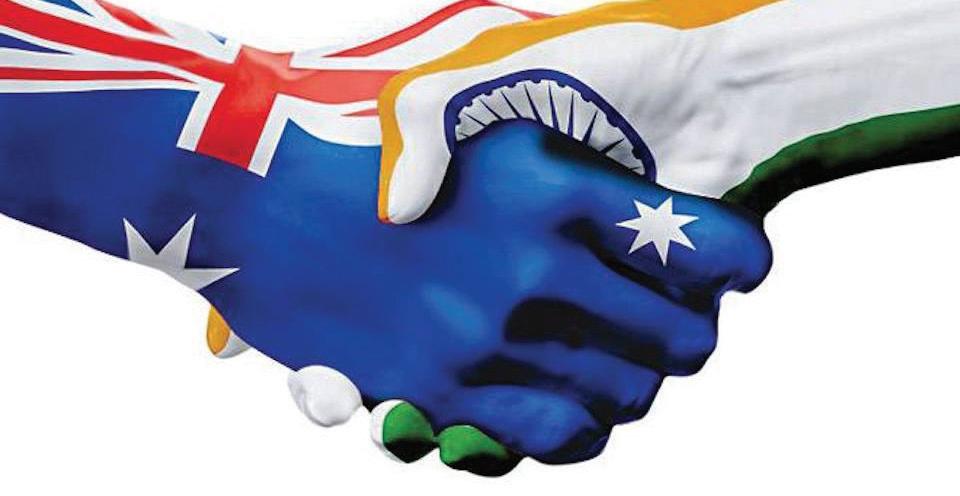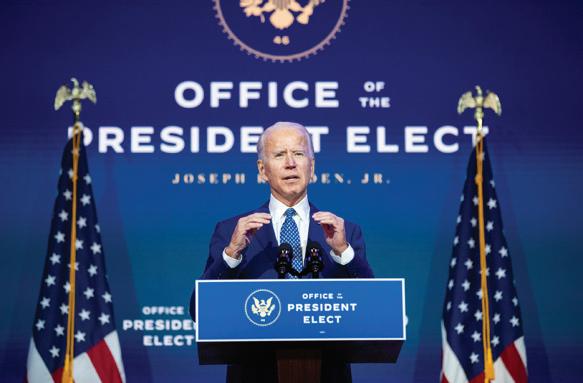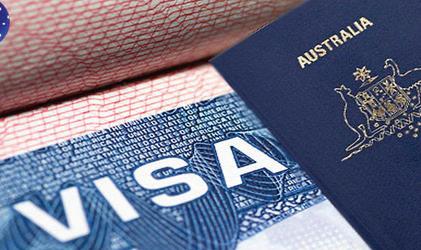April 1-15, 2021 - Vol 1, Issue 19
INDIA NEWS
EDITORIAL
Indian diaspora poised to Quad manthan in the Indoshape Australia-India ties Pacific heralds a new phase in Indo-Australian strategic partnership By Dr Ashutosh Misra
P T
he Australia Indian Comprehensive Strategic Partnership is witnessing a meteoric rise since the virtual summit of Narendra Modi and Scott Morrison transpired in June 2020. The summit was held amidst the global havoc caused by Covid-19, and as the world economies suffered a brutal battering from the pandemic, tensions with China spiralled dramatically. While Australia demanded an inquiry into the origins of the outbreak of the pandemic infuriating Beijing, Indian troops on the other hand were also locked into a bloody battle in the Ladakh sector with the People’s Liberation Army.
statistics, the role of the Indian diaspora remains still way below their potential. According to Surjeet Dhanji in a recent article in the Indian Express, “Australians of Indian origin account for 0.5 per cent of representatives in the federal parliament, 0.7 per cent in the Victorian state parliament, and even lower proportions for local councils in New South Wales (NSW) and Victoria. They are doing relatively well in the NSW state parliament, where they account for 1.5 percent of elected representatives”. In order to shape bilateral ties and Australia’s policy towards India, this record needs to improve considerably.
The cumulative effect of the two developments spurred Australia and India to deepen their bilateral ties and strategic engagement within the framework of Quad in the Indo-Pacific. The first virtual summit of the Quad leaders on 12 March has further brought Australia and India even closer. Strategic analysts on both sides are in agreement that Australia India bilateral business and trade ties will benefit from their growing cooperation in the Quadrilateral framework. In this context, the Indian diaspora in Australia has now a critical role to play in complementing business and trade ties and complementing the core objectives of the strategic partnership.
Similarly, the diaspora also needs to build their prominence in the corporate sector as well. Peter Varghese in his India Economic Strategy to 2035 observed, “Most Indian diaspora business in Australia are SMEs, and they too have the capacity to be meaningful drivers of economic integration with India”. But having said that Indian corporates Infosys, Tata Consultancy Services, Wipro, Tech Mahindra, HCL, Cyient, NIIT, iGATE (now part of CapGemini) and the Adani Mining (now named Bravus) are bolstering India’s footprint into the big corporate world.
Numbering over 700,000, constituting 2.8% of the Australian population, the Indians are the fourth largest and the fastest growing migrant community here. Around the years 2001-2017 around 400,000 people migrated to Australia. Of the 700,000 Indians 88% are of the working age and 61% are in full-time and 27% in apart-time employment. This makes them the second highest tax-paying migrant community after the UK-born migrants, contributing over $12 billion to the Australian economy. According to the Australian Bureau of Statistics Hindi is the largest spoken language in the community, followed by Punjabi, Malayalam, Gujarati, Tamil, Telugu, Urdu, Marathi, Kannada and Bengali. The Indian students contributing $6.6 billion to the Australian economy forming the second largest international cohort constituting over 15% of the Australian university enrolments. While these are impressive
www.indianews.com.au
Indian community organisations are now playing an even larger roles, attracting a larger turnout, of both Indians and non-Indian communities, in organising and celebrating major public events like Holi and Diwali across Australia, and enriching the multicultural ethos of Australia. In sum, the Indian diaspora has a major role to play in building India literacy not only in the cultural realm but also in business, trade, academia and strategic realms. This will not happen on its own, and the diaspora leaders depending on their individual expertise in various fields will have to push harder to build new academic and research programs and institutional collaborations, set up new businesses, host larger public events, assist Australian businesses in doing business with India, and also fight for a greater pie in the Australian politics. The constellation of bilateral, regional and global opportunities have never been so favourable, something the diaspora cannot afford to let slip away.
rime Minister Narendra Modi has labelled the inaugural leaders’ virtual summit as “Quad’s coming of age”. Quad’s evolution has been impeded for long by India and Australia's hesitation in formalising the Quad, owing to their own bilateral sensitivities towards China. But not anymore. In the wake of Australia's trade tensions with China which triggered by the former's demand for an inquiry into the origins of the Covid-19 outbreak, and on the other hand, India's military confrontation in Doklam and Ladakh with China, their strategic cooperation has grown manifold in recent months. Their newfound willingness to stand up to China’s irridentist claims, Hong Kong and Xinjiang crackdown and periodic diplomatic bellicosity and bluster in bilateral dealings has underpinned Quad’s fruition into a formal entity. The agenda for the inaugural Quad virtual summit was consciously kept quite wide including, Covid-19 strategy, vaccine production, climate change, supply chain disruptions, critical and emerging technologies and maritime security. The rationale being downplaying any "anti-China" posturing that Beijing may find disturbing and disruptive for the Indo-Pacific. The bourgeoning quadrilateral vision was carefully articulated in the first of its kind joint op-ed by the US President Joe Biden, and the three prime ministers, Yoshihide Suga, Scott Morrison and Narendra PM. But for the watchers of international politics the op-ed is a significant document for its ‘in-between the lines messaging’. For instance, the reference to ‘a group of democratic nations’ in the second paragraph is a veiled countervailing democratic pushback to China’s authoritarian and bullish international conduct under the garb of ‘peaceful rise’. In particular, the op-eds broad emphasis on making a joint effort to tackle Covid-19 pandemic is a clever strategy to win the hearts and minds of the ASEAN member states, Pacific Island countries (the focus of India’s Pacific Island Countries and Australia’s Pacific Step-up strategies) and the Indian Ocean littorals to offset the longrunning Chinese economic and military influence. It is a welcome development for states who have long been buried under the weight of China’s debt-diplomacy and military dominance but were unable to articulate their displeasure for fear of a punitive backlash from Beijing. The use of the phrase ‘dark hour’ in the oped is another indicator of how the
facebook.com/indianewsaustralia
Quad wants the regional states to look at the current state of affairs in the Indo-Pacific. While strategic commentators remained sceptical of Biden’s resolve in reining in the Chinese economic and military muscleflexing in the region, the decision to convene the historic virtual summit has put at bay some of those scepticism, at least for some time. The Quad’s messaging has not been lost on part of other regional democracies. South Korea too, has expressed its desire to join the Quad in a "transparent, open and inclusive" manner, a clear sign of how widespread the unease runs amongst the regional states with China’s overbearing influence in the region. So, what does the Quad mean for Australia and India relations? India’s External Affairs Minister Subrahmanyam Jaishankar has expressed great satisfaction in how the Australia-India ties have deepened in the wake of the Covid-19 pandemic, battering the two economies and causing hundreds and thousands of deaths. Since June 2020 when the inaugural Modi-Morrison virtual summit transpired, the Comprehensive Strategic Partnership has not only been deepening, but also become the fulcrum of the Quad’s new collective avatar for ensuring a safe, open and secure IndoPacific regional architecture. It is a double delight how the Quad and Australia-India bilateral business and trade ties have assumed a mutually complementary character. The growth of Quad will underpin the Australia-India strategic partnership and vice versa. Engagements on both fronts will chart a parallel course and should not be seen in isolation. Peter Varghese, the author of India Economic Strategy report had observed much before the Covid outbreak, “…the stronger that [Australia-India] broader relationship the better the prospect of an economic strategy.
India should not be seen only as a geopolitical partner”. Now New Delhi too sees Australia not only as an economic partner but also as a geopolitical partner, therefore vindicating the rationale for elevating their 2009 strategic partnership into a ‘comprehensive’ one. The Department of Foreign
Affairs and Trade observes that India’s youthful population and diversified growth trajectory present significant opportunity in education, agriculture energy, resource, tourism, healthcare, financial services and infrastructure among other areas. Both sides have formalised over 20 MoUs last June covering some of these areas during the Modi-Morrison virtual summit. Their two-way trade has risen from $13.6 billion to $30.4 billion in 2018, but it is still below their full potential. By 2035, both sides aim to double their bilateral trade and Australia seeks to bring India in its top 5 trading partners (currently 8th). Ambassador Anil Wadhwa’s Australia Economic Strategy report launched a few months ago could not have come at a more opportune time in bilateral and regional affairs. The report has identified 12 key sectors inter alia, mining, services and start-ups, pharmaceuticals, healthcare and medical technologies, education and skills, agribusiness, infrastructure, power and renewable energy, railways, gems and jewellery, automotive spare parts, and tourism. The report very nicely complements the recommendations of Varghese’s India Strategy across 10 sectors. Although, both reports lay less emphasis on defence cooperation, Quad’s evolution and new regional equations are likely to boost bilateral collaboration in drone development and shipbuilding. The Mutual Logistics Support Agreement and Island Support Agreement to use Andaman & Nicobar and Cocos (Keeling) Islands in the maritime domain, and India’s decision to include Australia into the Malabar Naval exercise, assume much greater significance in context of the Quad’s emergence. These are good signs even for the stalled negotiations on Comprehensive Economic Cooperation Agreement (CECA). Put wisely, Australia and India are now well-positioned to play their long-due leadership roles in the Indo-Pacific, and broadly speaking, in international affairs. Business and trade benefits to both would automatically accrue. It is a historic opportunity which must not be allowed to go untapped. Dr Ashutosh Misra is the CEO, Institute for Australia India Engagement, Brisbane, executive committee member Australia India Business Council (Queensland) and editor-inchief, India News Australia
24

















